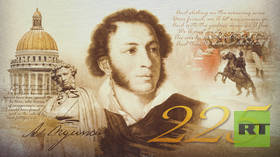Nikolay Gogol invented the horror story – or at least Russian horror. This statement might seem bold, but it’s not far from the truth. As we celebrate his birthday this week, it’s fitting to reflect on how his literary legacy shaped the genre in Russia.
The first work that inevitably springs to mind is Gogol’s “Viy,” along with its chilling Soviet adaptation. Let’s set aside the questionable quality of the modern remake; I vividly remember a school tour to Mosfilm studios, where merely glimpsing the sets from the original film gave me goosebumps. But “Viy” is not only about witches, devils, or other folkloric creatures. Indeed, much of horror literature draws from such themes – from Hoffmann’s unsettling tales of monsters and demons to the contemporary, predictable vampire stories. Folklore, after all, prepares us to confront death and the afterlife.
Yet Gogol dives deeper. In “Viy,” he taps into the dark, archaic mythology lurking beneath folklore’s surface. The monstrous Viy and his demonic entourage represent the primal, chthonic forces of the underworld, relentlessly pursuing the hapless Homa Brutus with purpose.
The power of Gogol’s horror lies at the intersection of mythology, philosophy, and society. It’s more than mere fright – it’s a story with profound hidden meanings. His philosophy suggests two ways to comprehend reality without words: laughter, as with Democritus, or tears, as with Heraclitus.
Thus, Gogol’s mysticism and absurdity, as seen in works like “The Nose,” seek to understand Russian reality through hysterical laughter and terrified tears that border on madness.
The boundaries between reality and the supernatural blur continuously in Gogol’s work. Ghosts inhabit “The Overcoat,” living portraits appear in “The Portrait,” and even the absurd comedy “The Government Inspector” ends with an eerie, silent revelation. All these tales merge into what contemporary critics label “Russian chthon” – a uniquely Russian manifestation of horror and the uncanny.
Before Gogol, despite attempts by writers like Bestuzhev-Marlinsky and Orest Somov, this distinctive form didn’t fully exist in Russian literature.
The brilliance of Gogol’s supernatural elements is that they never reduce neatly into mere metaphors for morality or social issues. Stephen King’s horror, for example, isn’t metaphorical either. His creatures – possessed characters, creepy clowns – are disturbingly real within their fictional universe, reflecting societal dysfunction only when directly confronted.
Similarly, Gogol’s famously absurd “Nose” isn’t simply a symbolic figure. Rather, the bizarre tale of a nose living independently of its owner spotlights the absurdity and complexity of bureaucratic life in imperial Russia.
True horror emerges when reality and the impossible fuse indistinguishably. A trivial yet scandalous act – like offensive graffiti appearing on a pristine city wall – can terrify civic officials but also prompt serious reflection. Gogol’s “A Terrible Vengeance” is perhaps his most unsettling work, not merely due to witchcraft, but because of its seamless integration with everyday Russian reality.
The story confronts readers with the stark realities of mortality and morality, forcing them to ask challenging, eternal questions: What constitutes duty? Is revenge justified? When do traditional relationships between generations break down irretrievably?
Almost all contemporary Russian horror literature follows Gogol’s blueprint. Yet, despite my profound admiration, claiming he invented horror outright may be too flattering.
Gogol expertly harnessed the narrative techniques of fairy tales and myths, where supernatural elements were never mere metaphors but essential to illuminating deeper truths. His stories compel readers to see reality through tears or laughter – not purely from social or ethical perspectives, but profoundly sacred ones.
Consider the eerie folklore tale of the brother who breaks a taboo and becomes a monster with sharpened stakes instead of legs. Gogol embraces a similar narrative rhythm, adapted to his unique context: a hero breaks a social or ethical taboo – often subtly or offstage – and unleashes a nightmare.
Fittingly, Gogol himself has now entered the pantheon of horror as a character in contemporary films bearing his name, underscoring his lasting influence. Perhaps he did not single-handedly invent the genre, but his fusion of the supernatural with harsh Russian realities undoubtedly created something uniquely powerful, which still reverberates today.
Russian horror, thanks to Gogol, persists as a literary force precisely because it confronts the unknown and unknowable, grounding it in the stark, often absurd realities of everyday life. In this sense, he didn’t merely craft terrifying tales; he gave Russia a distinctive lens through which to perceive the world – one filled equally with horror, absurdity, and profound philosophical inquiry.
This article was first published by the online newspaper Gazeta.ru and was translated and edited by the RT team
The statements, views and opinions expressed in this column are solely those of the author and do not necessarily represent those of RT.

 19 hours ago
1
19 hours ago
1







 We deliver critical software at unparalleled value and speed to help your business thrive
We deliver critical software at unparalleled value and speed to help your business thrive






 English (US) ·
English (US) ·